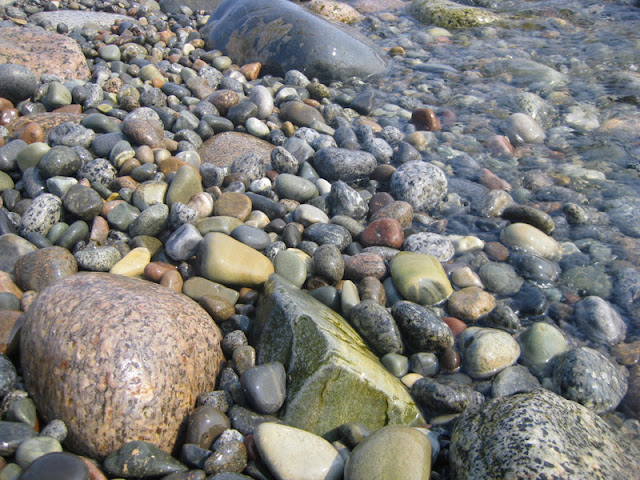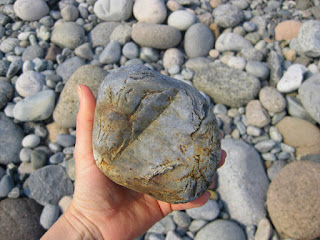The wind and sea have lashed the landscape of Mølen for thousands of years, and the place takes its name from the Old Norse word "mol", meaning a stone mound or bank of stones.
Mølen is also famous as one of Norway’s largest Viking era burial grounds and there are over 230 burial mounds located here. This, combined with its striking natural beauty and position on the edge of the sea, make it a must see when visiting the area.
A BITE OUT OF A ROCK
WE FOUND A TROLLS NOSE
BRADLEY WAS HUNGRY... A ROCK - TASTY!
Cultural history
The cultural landscape of Mølen, with its total of 230 cairns, is one of the most majestic in Norway. The area has 16 large cairns, many up to 35 m in diameter, with almost 200 small cairns in rows parallel to the shoreline. In one of the cairns, burnt stones were found; this could be the result of a cremation dating back to the 5th century A.D. The small cairns may symbolise warriors who fell in battle or were shipwrecked together with their captain.
Plundering
The cairns furthest down towards the sea are from the Late Iron Age and Viking times, while those on higher ground are probably older; theoretically, they could be from the Late Bronze Age, as was previously assumed. However, recent research shows that all the cairns of Mølen are probably from the Iron Age. Almost all the cairns have one or more depressions from plundering or so-called "haugbrot". "Haugbrot" refers to ritual removal of the dead; the reason why this was done is not clear. The low boat-shaped stone setting was excavated in the 1970s. It is a grave where a ship had probably been burnt. Iron nails and carbon were found, and these have been dated to approximately 30?250 A.D.
Different social strata
Why did some graves have a mound, while others had to make do with simpler forms. We do not know what ceremonies were linked to the burials, but it is thought that the most powerful members of society were given the most impressive grave sites, while ordinary people had to make do with simpler types of grave or were buried without any mound, cairn or bauta stones to mark the spot.
Trading centre
The cairns, which were clearly visible to shipping, not only signalled prosperity but probably also served as "sea markers" along the shipping lanes between different trading centres. The question is whether Mølen and its bay could have been one of several transit sites in Eastern Norway, with goods from here being exchanged and conveyed to the surrounding settlements.
Geology
Traces of volcanic activity. On Salstein, a southerly headland with a beach composed almost entirely of pebbles, we find rare traces of the so called Brunlane volcano. The volcano itself ceased to be part of the landscape a long time ago, but the dark types of rock on Saltstein are remnants of a defunct and deeply eroded shield volcano. Relics have also been found on Oddane and also on the skerries between Oddane, as well as to the south.
Lava, volcanic ash and corridors
The long headland of Saltstein comprises alternating layers of lava and volcanic ash. The lava is in the form of dark types of rock with white flecks. The white flecks were originally gas-filled bubbles. Volcanic ash can be seen in layers between individual layers of lava; it is often very stratified and green or brownish in colour. The ash resulted from volcanic eruptions. In the far west of Saltstein, there is an approximately 4 m thick layer of fragments of rock of various sizes. This layer was created in a massive volcanic eruption. Molten basal and rhomb porphyry forced its way up through the volcano after the lava had overflowed. Today, we can see these molten substances as east-west corridors on Saltstein.
Special volcanic activity
Late in the carbon time series, there was basaltic volcanic activity near Skien, Holmestrand, Jeløya and on Krokskogen and Kolsås, south of Oslo. This was the earliest volcanic activity in the Oslo area. The lava flows were like those we find on basal volcanoes today, e.g. on Iceland, Etna and Hawaii, but the Brunlane volcano has a very particular composition found today in eastern Congo near the town of Goma.
Glaciation
The smooth, sloping rock of Saltstein was ground by the glacier during the last Ice Age. Abraded strips show that the glacier moved from north to south. A nice way of approaching Mølen is to walk along the North Sea Trail from Nevlunghavn or Helgeroa. The trail is a more than 5000 km coastal walk in Norway, Sweden, Denmark, Germany, Netherlands, England and Scotland [1]
Environmental disasters
CLICK ON THE LINK TO SEE THE OTHER PICTURES FROM - Our ADVENTURE to Norway's largest beach of rolling stones - Mølen




















No comments:
Post a Comment